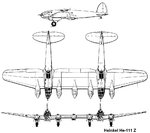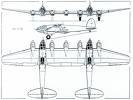B-17engineer
Colonel
Designed to pull the BIG Me-323 GIgant
With the introduction of the Me-321 Gigant heavy cargo glider in 1940 the Luftwaffe had a need for suitable towing aircraft. Neither the Ju-52 nor the Ju-90 had enough power. Using three Me-110's to tow the giant gliders proved impractical. To solve the need, Ernst Udet, director of air armaments and World War I ace conceived the idea of joining two existing bombers with a middle wing.
In 1941 two prototype He-111Z (Zwilling -Twin) aircraft were made using fuselages from He-111 bombers with a fifth engine added to the center section of the wing.
The Heinkel He-111 was the primary Luftwaffe medium bomber during the early stages of World War II, and is perhaps the most famous symbol of the German side of the Battle of Britain. Developed from a pre-war design, the He 111 was phased out of front line service in 1942, but remained in production until 1944.
The He-111Z entered production in early 1942 and was deployed later that same year. Only three months had elapsed between the prototype's first flights and delivery into service, with only days dedicated to service evaluation.
Despite its rapid development, after airframe strengthening the He-111Z entered service. It proved to be an efficient glider tug, with more than enough power to tow the new giant gliders. It could maintain level flight with three engines out, so long as the remaining two provided symmetrical power.
Take-off could be assisted by two 1,100 lb. thrust RATO rockets beneath each fuselage and two 3,307 lb. thrust rockets under the center wing section, one on each side of the middle engine.
For the large Me.321 glider, the towing cable was divided, and fixed at each central wing-root, joining between the tail planes into a single16 mm cable. Smaller gliders, such as the Go.242, could be towed in pairs on independent cables attached to each fuselage of the aircraft. A single He-111Z was able to tow three small gliders during trials, but this was not standard practice.
Only the prototypes and the first few production models used He-111H-6 airframes; the remainder were based on the He-111H-16.
The He-111Z carried a crew of seven. The pilot sat in the port fuselage, with five throttles, full instrumentation, and controls for the landing gear and radiator flaps for the three engines on his side. The copilot in the starboard fuselage was given dual controls but no throttles, and worked the starboard landing gear and two sets of starboard engine radiator flaps. The copilot also served as navigator. A mechanic, radio operator and gunner were housed in the port fuselage, and a mechanic and gunner in the starboard.
Normal armament consisted of a 20 mm MG FF cannon in the starboard nose position and an MG 15 in the port nose. Each fuselage had a single13 mm MG 131 in the dorsal position, a single 7.9 mm MG 15 in the rear of the ventral position and a MG 15 in a beam hatch of each fuselage. Various other armament configu- rations were tried, including four 13 mm MG 131s, two MG 91Z paired 7.9 mm installations, and five single MG 81Js.
The He-111Z was very successful, well liked by its crews and enjoyed a trouble free career.
Of the 12 He-111Zs produced, 8 were either shot down or destroyed from bombings. The fate of the remaining 4 is unclear.
Specifications
Primary Function:
Crew:
Engines:
Power:
Weight Empty:
Max. Weight: Length:
Wingspan:
Cruise Speed:
Towing Me-321:
Towing 2 Go-342:
Ceiling:
Range:
Year Deployed: glider tow
seven
Junkers Jumo
5- V 1,350 hp ea.
47,000 lbs.
53,000 lbs.
53' 10"
115' 6"
270 mph
137 mph
155 mph
32,500 feet
1,200 miles
1942
With the introduction of the Me-321 Gigant heavy cargo glider in 1940 the Luftwaffe had a need for suitable towing aircraft. Neither the Ju-52 nor the Ju-90 had enough power. Using three Me-110's to tow the giant gliders proved impractical. To solve the need, Ernst Udet, director of air armaments and World War I ace conceived the idea of joining two existing bombers with a middle wing.
In 1941 two prototype He-111Z (Zwilling -Twin) aircraft were made using fuselages from He-111 bombers with a fifth engine added to the center section of the wing.
The Heinkel He-111 was the primary Luftwaffe medium bomber during the early stages of World War II, and is perhaps the most famous symbol of the German side of the Battle of Britain. Developed from a pre-war design, the He 111 was phased out of front line service in 1942, but remained in production until 1944.
The He-111Z entered production in early 1942 and was deployed later that same year. Only three months had elapsed between the prototype's first flights and delivery into service, with only days dedicated to service evaluation.
Despite its rapid development, after airframe strengthening the He-111Z entered service. It proved to be an efficient glider tug, with more than enough power to tow the new giant gliders. It could maintain level flight with three engines out, so long as the remaining two provided symmetrical power.
Take-off could be assisted by two 1,100 lb. thrust RATO rockets beneath each fuselage and two 3,307 lb. thrust rockets under the center wing section, one on each side of the middle engine.
For the large Me.321 glider, the towing cable was divided, and fixed at each central wing-root, joining between the tail planes into a single16 mm cable. Smaller gliders, such as the Go.242, could be towed in pairs on independent cables attached to each fuselage of the aircraft. A single He-111Z was able to tow three small gliders during trials, but this was not standard practice.
Only the prototypes and the first few production models used He-111H-6 airframes; the remainder were based on the He-111H-16.
The He-111Z carried a crew of seven. The pilot sat in the port fuselage, with five throttles, full instrumentation, and controls for the landing gear and radiator flaps for the three engines on his side. The copilot in the starboard fuselage was given dual controls but no throttles, and worked the starboard landing gear and two sets of starboard engine radiator flaps. The copilot also served as navigator. A mechanic, radio operator and gunner were housed in the port fuselage, and a mechanic and gunner in the starboard.
Normal armament consisted of a 20 mm MG FF cannon in the starboard nose position and an MG 15 in the port nose. Each fuselage had a single13 mm MG 131 in the dorsal position, a single 7.9 mm MG 15 in the rear of the ventral position and a MG 15 in a beam hatch of each fuselage. Various other armament configu- rations were tried, including four 13 mm MG 131s, two MG 91Z paired 7.9 mm installations, and five single MG 81Js.
The He-111Z was very successful, well liked by its crews and enjoyed a trouble free career.
Of the 12 He-111Zs produced, 8 were either shot down or destroyed from bombings. The fate of the remaining 4 is unclear.
Specifications
Primary Function:
Crew:
Engines:
Power:
Weight Empty:
Max. Weight: Length:
Wingspan:
Cruise Speed:
Towing Me-321:
Towing 2 Go-342:
Ceiling:
Range:
Year Deployed: glider tow
seven
Junkers Jumo
5- V 1,350 hp ea.
47,000 lbs.
53,000 lbs.
53' 10"
115' 6"
270 mph
137 mph
155 mph
32,500 feet
1,200 miles
1942





